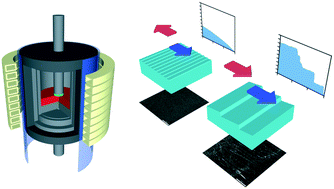Application of C-face dislocation conversion to 2 inch SiC crystal growth on an off-axis seed crystal
Abstract
The conversion of threading screw dislocations (TSDs) to defects on basal planes during SiC solution growth caused by advancing macrosteps is a key factor for high-quality crystal growth. To study this effect for large growth areas, a 2 inch 4H-SiC crystal was grown on the C face of a 1° off-axis seed crystal using the top-seeded solution growth method. Step-flow growth towards the [11![[2 with combining macron]](https://www.rsc.org/images/entities/char_0032_0304.gif) 0] direction occurred over the entire growth surface. Inhomogeneities in the surface morphology were observed. The step height increased monotonically along the step-flow direction. The non-uniform step height resulted in a spatial distribution of TSD conversion. Little conversion took place in the upstream area of step flow with small steps. In contrast, conversion happened frequently in the centre of the crystal and in the downstream area, with a conversion ratio as high as 80% in these areas. According to a numerical simulation, the solution flow direction was outward near the growth surface. The solution flow affected the steps adversely in the upstream and downstream areas, resulting in a spatial distribution of step height and TSD conversion ratio. This study revealed that the solution flow direction is a key factor for the growth of large high-quality crystals.
0] direction occurred over the entire growth surface. Inhomogeneities in the surface morphology were observed. The step height increased monotonically along the step-flow direction. The non-uniform step height resulted in a spatial distribution of TSD conversion. Little conversion took place in the upstream area of step flow with small steps. In contrast, conversion happened frequently in the centre of the crystal and in the downstream area, with a conversion ratio as high as 80% in these areas. According to a numerical simulation, the solution flow direction was outward near the growth surface. The solution flow affected the steps adversely in the upstream and downstream areas, resulting in a spatial distribution of step height and TSD conversion ratio. This study revealed that the solution flow direction is a key factor for the growth of large high-quality crystals.



 Please wait while we load your content...
Please wait while we load your content...